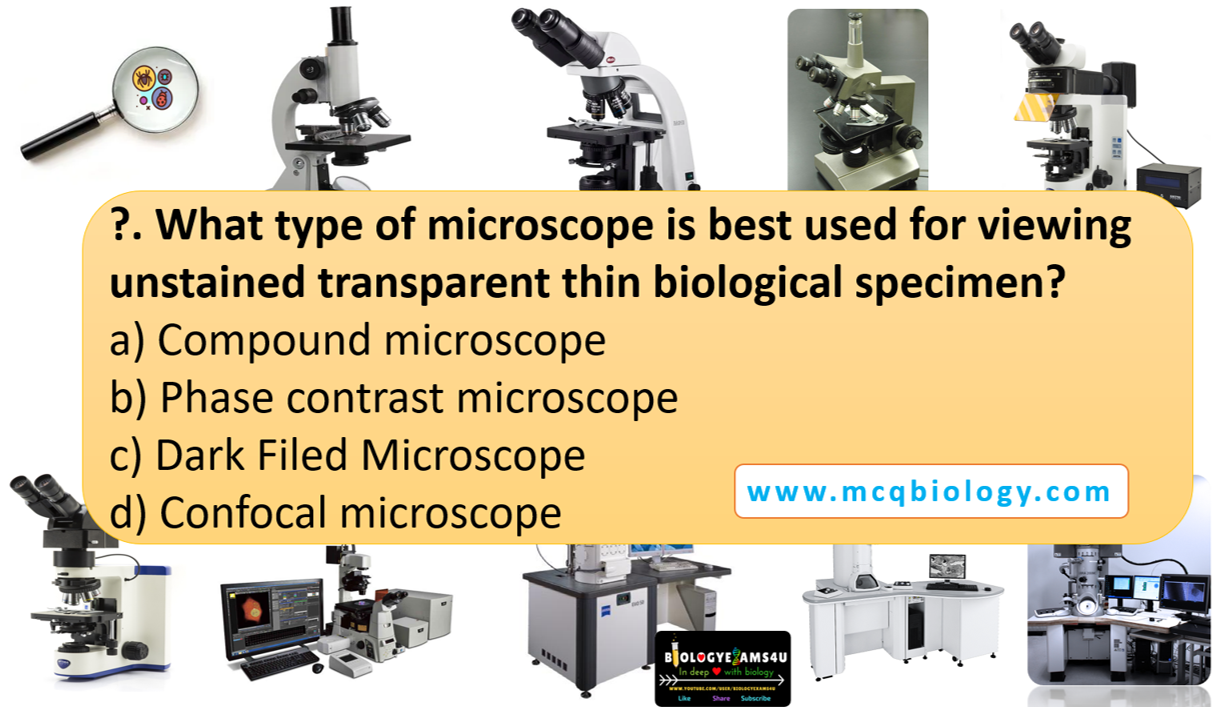MCQ on Types of Microscope
1. Which microscope is optimal for observing living cells?
a) Compound microscope
b) Scanning electron microscope
c) Transmission electron microscope
d) Scanning Transmission electron microscope
2. What is the best microscope for
examining a specimen's surface in 3D?
a) Compound
microscope
b) Scanning electron microscope
c) Transmission
electron microscope
d) Phase
contrast microscope
3 What
type of microscope is best used for viewing the ultra-structure of cell organelles
of a cell?
a) Compound microscope
b) Scanning electron microscope
c) Transmission electron
microscope
d) Confocal microscope
4. What type of microscope uses a focused
laser beam to create an image?
a) Phase contrast microscope
b) Scanning electron microscope
c) Transmission electron microscope
d) Confocal microscope
5. Which of the following microscope
has the highest magnification power?
a) DIC
b) Scanning electron microscope
c) Transmission electron
microscope
d) Confocal microscope
6. What type of microscope is best
used for observing the movement of cell structures in real-time?
a) DIC
b) Scanning electron microscope
c) Transmission electron microscope
d) Confocal microscope
7. Which microscope uses a phase plate and
condenser annulus to create high contrast images of
live specimens?
a) Phase contrast microscope
b) Scanning electron microscope
c) Transmission electron microscope
d) Confocal microscope
8. Which microscope is an example of a
simple microscope?
a) Phase contrast microscope
b) Dissection
microscope
c) Dark field microscope
d) Confocal microscope
9. The magnification of a compound
microscope with an eye piece of 10X and objective of 40X is?
a) 40X
b) 400X
c) 4000X
d) 4X
10. What type of microscope is best used
for viewing unstained transparent thin biological specimen?
a) Compound microscope
b) Phase contrast microscope
c) Dark Filed Microscope
d) Confocal microscope
Watch our simplified summary video on Microscopes
11. What type of microscope uses polarized light and beam splitter
to create 3D like high contrast images?
a) Differential Interference Contrast Microscope
b) Phase contrast microscope
c) Dark Filed Microscope
d) Confocal microscope
12. What type of microscope is used to view fluorescently-labelled
specimens in high contrast?
a) Differential Interference Contrast Microscope
b) Phase contrast microscope
c) Dark Filed Microscope
d) Fluorescence Microscope
13. What type of microscope is used to create images with high
magnification and high depth of focus?
a) Nomarski
microscopy
b) Scanning
electron microscope
c) Transmission
electron microscope
d) Phase
contrast microscope
14. Which of the following statements are true regarding TEM?
a) Require extremely thin samples
b) Require
skilled operators
c) Cannot view living specimens (less than 150nm)
d) All of the above
15. Which of the following statements are true regarding Scanning
Transmission Electron Microscope (STEM)?
a) produce high-resolution images of thin samples
b) Combination of SEM and TEM
c) Sensitive to contamination
d) All
of the above
Answers
1. a) Compound microscope
2. b) Scanning electron microscope
3. c) Transmission electron microscope
4. d) Confocal microscope
5. c) Transmission electron microscope
6. d) Confocal microscope
7. a) Phase contrast microscope
8. b) Dissection microscope
9. b) 400X
10. c) Dark Filed Microscope
11. a) Differential Interference Contrast Microscope
12. d) Fluorescence Microscope
13. b) Scanning electron
microscope
14. d) All of the above
15. d) All of the above
